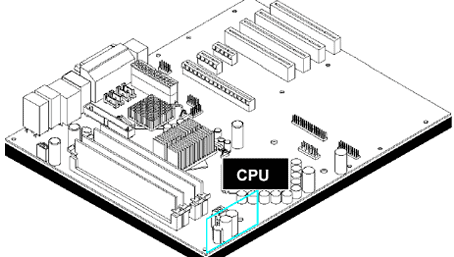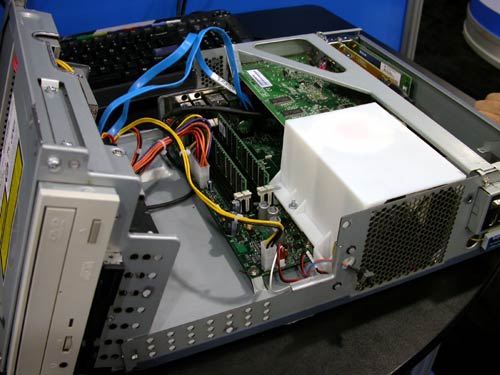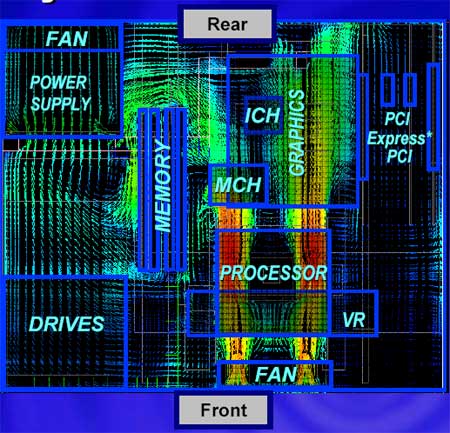Balanced Technology eXtended (BTX) Form Factor - The Future of Cases & Motherboards
by Anand Lal Shimpi on September 18, 2003 12:34 PM EST- Posted in
- Cases/Cooling/PSUs
BTX - The Basics
Just in case you were told otherwise, the BTX form factor is largely incompatible with the ATX form factor - the only area where this doesn't fully apply is in power supply support, as you can use ATX power supplies with BTX motherboards (more on this later).
In order to understand BTX you have to understand the motives for change. CPUs are getting hotter, graphics cards are as well, and despite all of these increases in thermal dissipation there is an increase in demand for quieter PCs. Today's ATX cases and motherboards were not designed for the incredible levels of heat that they have to deal with, and it is with this that we begin our understanding of BTX.
Pictured below you will see a BTX motherboard reference design:

The first thing that you'll notice about the BTX form factor is that the expansion slots have switched sides. In the picture above you'll see a total of 7 slots, from left to right we have a PCI Express x16 slot, two PCI Express x1 slots and four 32-bit PCI slots. Note that the slot closest to the CPU is the PCI Express x16 slot, which will be used for graphics, allowing it to share some of the CPU's cooling.
The redesign of the board layout was done in order to improve airflow through the system; moving the CPU to the "front" of the case allows it to be right next to the intake fan, giving it the coolest air out of any component in the system. You will then notice that the chipset is directly in line with the CPU, allowing airflow over the CPU's heatsink to be channeled over those heatsinks as well before exiting the case. This direct line of airflow allows for very efficient cooling of not only the CPU, but the voltage regulators, chipset and graphics card.
The memory slots have been moved to the left edge of the motherboard, but are also able to receive cooling courtesy of the thermal module, as it is known, that is mounted over the CPU. You can see a good example of what the thermal module will look like below:

The white plastic duct encloses what is known as the "thermal module," which at this point is basically a heatsink and a fan. In the future, the thermal module could encapsulate some more exotic cooling forms such as heatpipes or potentially even water cooling. In this particular design, the fan seen above is a 90mm unit.
In order to understand the cooling flow within a BTX system, take a look at the picture below:

In the depiction above the graphics card is mounted on a riser card, although it can also be mounted vertically.










99 Comments
View All Comments
Anonymous User - Thursday, September 18, 2003 - link
This is obviously Intel getting bought off by the cae industry. If a mirror image of the btx was used instead it would be compatible with existing ATX cases, provided a front fan was installed and the screw holes lined up. I cannot imagine any other explanation for flip-flopping the motherboard other than to make it completely neccesary to buy a new box for your rig.Anonymous User - Thursday, September 18, 2003 - link
I don't understand why with the AGP slot, no manufacturer ever thought to just put the GPU and Memory on the back of the card? It's not like it wouldn't fit in 99% of the cases/MBs, and with PCI Express they could have just flipped it around, as they did when PCI came out (Compared to ISA) then you could have both PCI and PCI Express (although I don't know why that would be good), and on the same know, have AGP and 16x. Actually, this is sounding better as I think about it, is it just me? As far as moving the CPU, you don't need a new specification to do that, Intel is just making sure their new 100w CPU works ok in small cases. Go intel!!! I actually hope AMD doesn't fallow this and succeeds.Is this an Intel specification, cause I didn't here any other company's being on any press release?
Anonymous User - Thursday, September 18, 2003 - link
I hope there's a PS/2 to USB adapter for my IBM Model M =(Don't those need special controllers or something? Oh angst. Anyone?
Anonymous User - Thursday, September 18, 2003 - link
It's interesting that they propose to make the CPU the first thing to be cooled by the fresh, cool air being sucked into the chassis. This means that just about everything else will be basking in the warmth from said CPU.Of course they might figure that with a single point of entry for the air, the air flow would be so high that the air wouldn't get that hot. Some how I fear that this won't be a very good solution for high-end workstations. It is much the same idea that they used for the initial ATX standard. It didn’t take many months’ before that was silently revised. By now it's hard to find any evidence whatsoever of those early ATX specifications.
dvinnen - Thursday, September 18, 2003 - link
I'm a little torn about this. Moving the CPU was a good idea I guess. And it's finally time to get rid of Parllel, Serial, and PS/2 ports? Who actually uses parrlel or serial? But why dose it have to be incompatible with current cases? Don't make since to me. Not enough change to warrent it.Anonymous User - Thursday, September 18, 2003 - link
Don't hold your breath waiting for some thing truly useful, such as a standard for the front/case connectors. Intel had the chance with NLX, but missed it. They didn't even try touching these connectors with ATX.WTX, who cares? Its dead, and good riddance to it!
SSI, well now we are talking, but sadly no standard for the front panel connectors.
Micro ATX and Flex ATX, one of these must have had some standard for the front panel connectors? Nope!
Partly this is understandable. There are a staggering amount of motherboards, and the variation when it comes to ports, switches and LED’s are huge.
Even so I would be happy if there were a standard for the most common: Power switch, Reset switch, Power LED, HDD LED. That way you could have a working system up and running without having to either decipher microscopic markings on the MB, or digging the manual out of the round filing cabinet.
And please, for the love of what ever is holy, standardize the USB and FireWire headers. And if there still is Com ports, or a parallel port header, then make sure these also follow a common standard! Counter to popular believes, neither the headers for the serial ports, nor those for parallel ports are standardized today. Each manufacturer uses whatever pin out they fancy, and some times this is a major PITA.
jamesey - Thursday, September 18, 2003 - link
1. why cant current mobo's simply move the cpu down and near the fan.2. why cant current mobobs be designed to have a PCIX vid card fit in an ATX case?
3. This all seems uncessary.
Anonymous User - Thursday, September 18, 2003 - link
i like the way intel is legacy out the door. i doubt an avg consumer can afford an abit max just to be legacy free. but what i'm having trouble understanding is if the cpu, say a prescott w/ 100 watts of heat, is up front and getting the most cool air, won't it raise the case temp dramatically regardless, since its moving warmer air to an already hot gfx card and other components?Anonymous User - Thursday, September 18, 2003 - link
I would also like to know whether the horribly irritating job of plugging in speaker, power on switch, reset switch et al has been FINALLY eliminated by putting all the leads in a single connector. Which should have btw been done in ATX already.ChemMan - Thursday, September 18, 2003 - link
I agree, I don't see the "innovation" in all of this. It seems as though the current ATX design was mirrored and the processor moved to the front of the board. I suspect the motivation of this design was less "innovation" and more industry endorsed obsolescence in an effort to sell new parts.